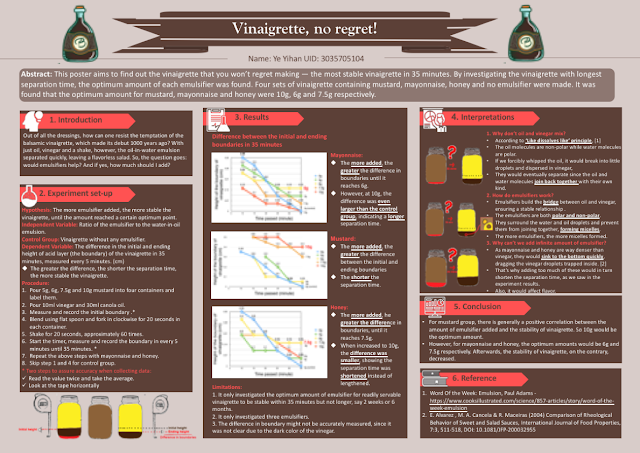Final experiment by Cheung Chin Pang (3035641712)
Final experiment
for
Relationship between the taste of dressing and the bowl you stirred.
What has been changed?
- The method for scaling ingredients
According to the previous ingredient, one of the common errors I have is the accurate amount of ingredients added for each dressing. To minimize the error made, instead of pour in the ingredients directly into the bowl, this time I used a teaspoon.
Also, I used separate porcelain bowl for each ingredient scaling, make sure each of them is accurate in amount.
So each ingredient can avoid the situation of spilled in too much amount than expected.
- The mixing time for each dressing
In the last experiment, I set the mixing time to 2 minutes 38 seconds for all dressing. To make it simple, I set all of them to 3 minutes this time.
- The electric scale
This time a new electric scale is adopted. Since the old one is broken.
- Amount of ingredients in the recipe
In the previous experiment, I can't find the fresh mint leaves. And this time, I still can't find it. But I figured out another alternative way. By using the teaspoon, the amount of dry mint or sea salt can be more accurate.
So I change the recipe
From
6 shakes of dry mint 1 teaspoon of dry mint
→→→
1.25g sea salt a half scoop of sea salt
Such changes should make the ingredients used in each dressing more clear and less fluctuate.
New recipe
- 64g olive oil
- 64g vinegar
- 1 teaspoon of dry mint
- 45g honey
- 15g Dijon mustard
- 2 roughly cut garlic cloves
- A half scoop of sea salt
- 10 twists of ground black pepper
Let's start again the last experiment
All ingredients
All utensils
All tools
First utensil: Aluminum bowl
First step
Open the garlic and pick two cloves. By pressing them under the knife, makes it easier to peel off the skin outside the clove. then cut them roughly.
Second step
Put all ingredients in a non-reactive bowl (porcelain) for scaling.
(Extra-virgin olive oil)
(1 teaspoon of dry mint)
(A half scoop of sea salt)
This time all ingredients have been added carefully. Won't have any huge difference in the amount.
Then after the scaling, I put all ingredients in the aluminum bowl and start stirring for 3 minutes.
After the stirring, I put the dressing in another non-reactive bowl. Covered it by plastic wrap and start the next dressing of stirring in a stainless-steel utensil.
Same step of the previous utensil
Second utensil: stainless-steel bowl
(Vinegar expected to be 64g)
Compare to last experiment, this time the amount of vinegar has been closer to the expectation.
Again, mixing for 3 minutes straight
Covered the second dressing with plastic wrap and start the last dressing making.
Third utensil: glass bowl
Again, the same steps as always. And this time all ingredients are matched with the recipe perfectly.
Lastly, MIXING!
By covered the last dressing with plastic wrap in a porcelain bowl and marked them with numbers
Finish!
Time for guests taste again
No.1 is the dressing mix in the aluminum bowl
No.2 is the dressing mix in the stainless-steel bowl
No.3 is the dressing mix in the glass bowl

Details of test
Volunteers (my family, of course, I don't think people outside will like to taste things in the current situation) are being asked to rate the bitterness of dressing after each bowl tasted.
Moreover, after tasted each bowl, the teaspoon need to be cleaned to avoid the next dressing being mixed with the previous one.
They won't be told that which of them are being mixed in which utensil.
Bitterness (from 1 to 10)
1 is the least bitterness
10 is the most bitterness
One decimal place is allowed.
No.2 is the dressing mix in the stainless-steel bowl
No.3 is the dressing mix in the glass bowl

Details of test
Volunteers (my family, of course, I don't think people outside will like to taste things in the current situation) are being asked to rate the bitterness of dressing after each bowl tasted.
Moreover, after tasted each bowl, the teaspoon need to be cleaned to avoid the next dressing being mixed with the previous one.
They won't be told that which of them are being mixed in which utensil.
Bitterness (from 1 to 10)
1 is the least bitterness
10 is the most bitterness
One decimal place is allowed.
Finally, the test is finished.
Results
Analyze time
Aluminum bowl
|
Stainless-steel bowl
|
Glass bowl
| |
Mom
|
5
|
2
|
1
|
Sister
|
5
|
3
|
2
|
Younger sister
|
7
|
4
|
4
|
Average
|
(5+5+7)/3 = 5.67
|
(2+3+4)/3 = 3
|
(1+2+4)/3 = 2.33
|
Again, my hypothesis is
The dressing mix on the aluminum bowl will have the most bitterness. Then will be the dressing on stainless steel and glass respectively.
Refer to my result in this last experiment, proved that my hypothesis is right.
Dressing mix in the aluminum bowl is the most bitterness.
Then will be the dressings in stainless-steel bowl and glass bowl.



















Comments
Post a Comment